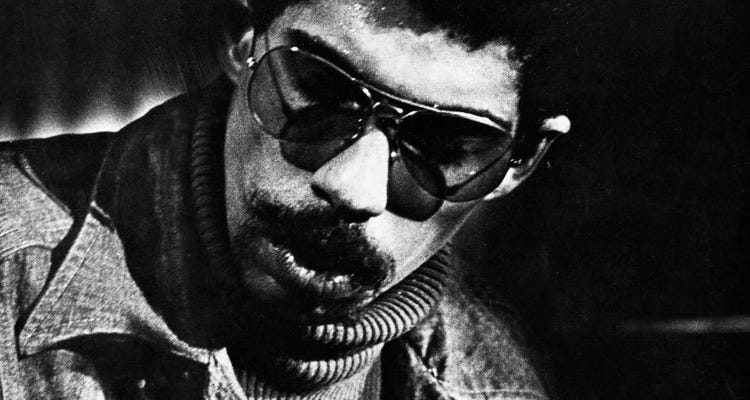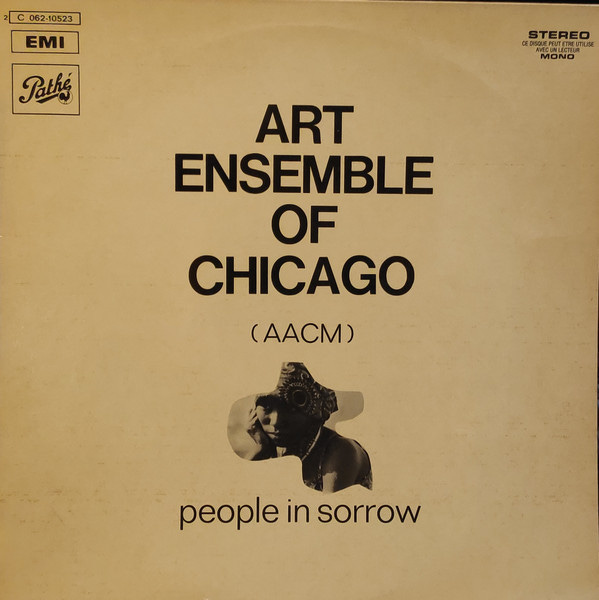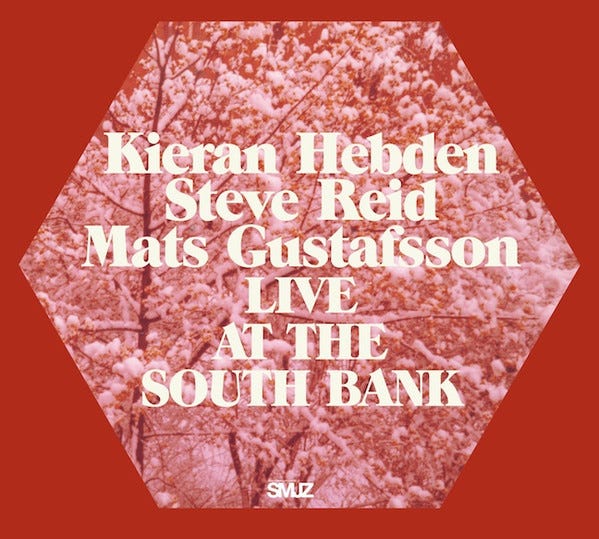I became a kind of local hero. There weren’t many drummers that actually come from New York. They all wind up there but they’re not from there.
-Steve Reid
In 1990, I saw Steve Lacy’s Sextet play at Koncepts Cultural Gallery in Oakland. I had developed into a huge fan after hearing Regeneration, his 1983 collaboration with Roswell Rudd, Kent Carter, and two Dutch musicians, Misha Mengelberg and Han Bennink. The album featured one side with Herbie Nichols’s tunes and the other with Monk's tunes. This was a very rare opportunity to see the expatriate Lacy playing in America, let alone all the way out on the West Coast. The show was fantastic.
I met with Lacy afterward and he signed this The Wire magazine - the landmark magazine’s first issue, which is still going strong today.
He loved that I actually had a copy of this first issue. After all, the magazine takes its name from Lacy’s composition The Wire, from his album of the same name, released in 1977 on the Japanese Denon Jazz label.
At this show, I also met Anthony Braxton. I asked him about the AACM, and he told me to just call their office in Chicago. He gave me the number and later I cold called them. A voice answered, “Hello, this is Sparx.” I didn’t know it at the time, but this was the legendary early AACM member Martin “Sparx” Alexander, who played trombone in the AACM Big Band directed by Muhal Richard Abrams.
I told him I was living in San Francisco and trying to get some information about the AACM for an article I was writing for the Peninsula Times Tribune. He told me he had a few things he could send my way. He also shared with me that Lester Bowie and Don Moye would be coming out to Oakland the following week. I asked if there was a chance I could interview Bowie. He told me to talk to Moye and gave me his phone number.
I called Don, and he told me to look him up after their show at Kimball’s East - I think it was there. I’m a little foggy on which club and details, but it was a Brass Fantasy show with Steve Turre on trombone.
After the show, I connected with Don. We talked for a few minutes; and he introduced me to Lester, who just said, “Hi. Meet me at the Washington Inn in the morning for breakfast at like 9:30, OK?” I responded, “Ok. I’ll see you then.” And off they went.
I’ll never forget that morning. I was sitting in the dining hall waiting for Lester. Then down the main staircase came Lester, his wife, and children - two or three, I can’t recall. We all had breakfast together. After we finished eating, his wife took the kids upstairs. We talked for a while, mostly about the Army. When I finally got around to asking him about the Art Ensemble of Chicago, he told me to look into People in Sorrow:
This album was first released in 1969 in France on the Pathé label, but the copy I found at Amoeba Records in Berkeley was the 1971 reissue on the Nessa label. You can read more about Chuck Nessa’s amazing label here:
It was from that album that I became interested in music on the Nessa label. Before too long I ran across Nessa’s record Saga of the Outlaws, recorded on May 20, 1976, at Sam and Beatrice Rivers’s loft called Studio Rivbea in New York City's NoHo district:
This is a fantastic album that features along with Tyler, Sun Ra alumni Ronnie Boykins and John Ore, and Steve Reid on drums.
Reid is perhaps most well-known for his work as a leader on his Mustevic Sound label, beginning with Rhythmatism recorded in late 1975 and released in 1976:
However, this week on that Big River called Jazz, we’ll pick up Reid further downriver with his collaboration with Kieran Hebden, most well-known by his alias Four Tet.
Steve Reid was born in New York. As a teenager, he lived in Queens and became fascinated by the jazz drumming of Art Blakey. He took to the drums at 16 and worked in the house band at the Apollo Theater. Three years later he made his first recording with Martha and the Vandellas. After graduating from Adelphi University in New York in 1965, he spent three years traveling Africa playing drums in Nigeria, Liberia, Sierra Leone, Senegal, and Ghana, where he met percussionist legend Guy Warren. He also worked with the bandleader Fela Kuti in Lagos, and with the American expat pianist Randy Weston in Tangier.
In 1969 Reid refused to register for the draft during the Vietnam War and was sentenced to four years at Lewisburg Federal Prison in Pennsylvania. In 1974, he formed the Legendary Master Brotherhood and recorded some nice albums on his label Mustevix Sound. In 1975 he recorded on two seminal free jazz classics: Frank Lowe’s Fresh and Charle Tyler’s Voyage from Jericho, released on Tyler’s AK-BA Records label. Reid continued to record with Tyler throughout the 1970s and early 1980s. He also recorded with Arthur Blythe on the India Navigation label and with Sun Ra’s Arkestra before appearing on Miles Davis’s Tutu (1986). However, it was a series of duo recordings with English electronic musician Hebden that brought Reid deservedly back into prominence.
In March and April 2005 in Paris and London, Hebden performed two shows of improvisational music with Reid. This collaboration led to Kieran joining the Steve Reid Ensemble for their 2005 album Spirit Walk, released on the English label Soul Jazz, with whom Reid had been working for over a decade:
From that album here is Unity:
This collaboration extended into a series of international tours and throughout 2005 and 2006 the release of two albums: The Exchange Session Vol. 1 and Vol. 2.
These sessions were important by bringing into the jazz world younger audiences - in this case, the free jazz world. For example, in April 2006, the Scala club in King's Cross, central London, housed close to 1,000 people, many of them teenagers, for an unusual kind of free jazz performance by a young electronica artist and a 62-year-old American free jazz drummer.
That same year, Hebden told Guardian's main jazz critic John Fordham about the essence of his partnership with Reid:
Steve and I see rhythm as the best way for us to push forward and make a new music. Through rhythm we can bring together the heavy jazz influence, the hip-hop influence, the techno influence ... it's a different era in music now, a time when rhythm is what can really communicate to people. We are trying to use this and all of our influences to make something new ... call it jazz, dance, whatever people want. We present it as a positive thing, there to bring happiness and joy, to make people feel good.
From The Exchange Session Vol. 1 here is Morning Prayer:
From The Exchange Session Vol. 2 here is Noemie:
I find these albums some of Reid’s most compelling work, and they alone would make a career for many; however, coupled with Reid’s extensive recording history, they only further build on his already legendary career.
In January 2007, the Steve Reid Ensemble with Hebden traveled to Africa and at the Studio Dogo in Dakar, Senegal recorded Daxaar:
While I applaud how this album tries to expose a natural connection between jazz and Africa, in the way albums like Archie Shepp’s Live at the Pan-African Festival did, Daxaar is my least favorite of their collaborations. I favor their duo format.
Here’s one more for the road. On June 20, 2009, Reid and Hebden, along with saxophonist Mats Gustafsson, recorded a killer live album in South Bank, London called simply Live at the South Bank:
From the album here is Lyman Place, a street Reid grew up on in New York City:
Playing with all possible fire, Gustafsson’s attack reminds me of the late Peter Brötzmann, who Gustafsson helped honor for three nights at Pardon, To Tu in Warsaw, Poland, from May 27 to May 29, 2024. Gustafsson is doing incredible yeoman’s work for jazz, and we’ll catch up with him a little further down the river…
The Steve Reid Foundation was started by Gilles Peterson in 2012, a non-profit organization designed to help people working in music who are in crisis, as well as support emerging talent through education initiatives.
On the website, Peterson wrote:
In 2009, Steve was diagnosed with throat cancer, and it was during one of my visits to New York that I became aware of the extent of his suffering. I was horrified by the conditions he was living in during his last days. He was practically living in near poverty, and he couldn’t afford the medical treatment he needed that might have saved his life. Steve died in 13 April 2010.
Steve is one of the most remarkable people I have ever met. Aside from having enormous talent, the most incredible stories and a zest for life, he had a big heart and a generous spirit, and to this day I feel humbled when I remember how modest he was. I can’t think of a better way to celebrate Steve Reid’s life than to start a charity to help other musicians in his name. If you love music like I do, please support the people making it.
Please consider donating to this important cause.
So much more could be written about Steve Reid’s amazing half-a-century in jazz, but we’ll have to save that for another journey a little further down the river.
Next week on that Big River called Jazz, we’ll dig our paddles into the waters of Bob Marley.
Please hit this link to buy me a cup of coffee, if you’d like to show your guide some appreciation for this and past journeys. Know in advance that I thank you for your kindness and support.
If you like what you’ve been reading and hearing so far on our journey and would like to share this with someone you think might be interested in learning more about our great American art form: Jazz, just hit the “Share” button.
From Astaire to Sun Ra: A Jazz Journey is a reader-supported publication. If you feel so inclined, subscribe to my journey by hitting the “Subscribe now” button.
Also, find my playlist on Spotify: From Fred Astaire to Sun Ra.
Feel free to contact me at any time to talk shop. I welcome and encourage that.
Until then, keep on walking….












Thank you for this. It brought back memories of seeing many of these same artists in the 70s & early 80s.
Another great read Tyler, thanks. Breakfast with Bowie, that's a great story. I saw Bras Fantasy about that time, very memorable.
I didn't know Reid was on Tutu. I was at that Scala gig, I wasn't a teenager though...